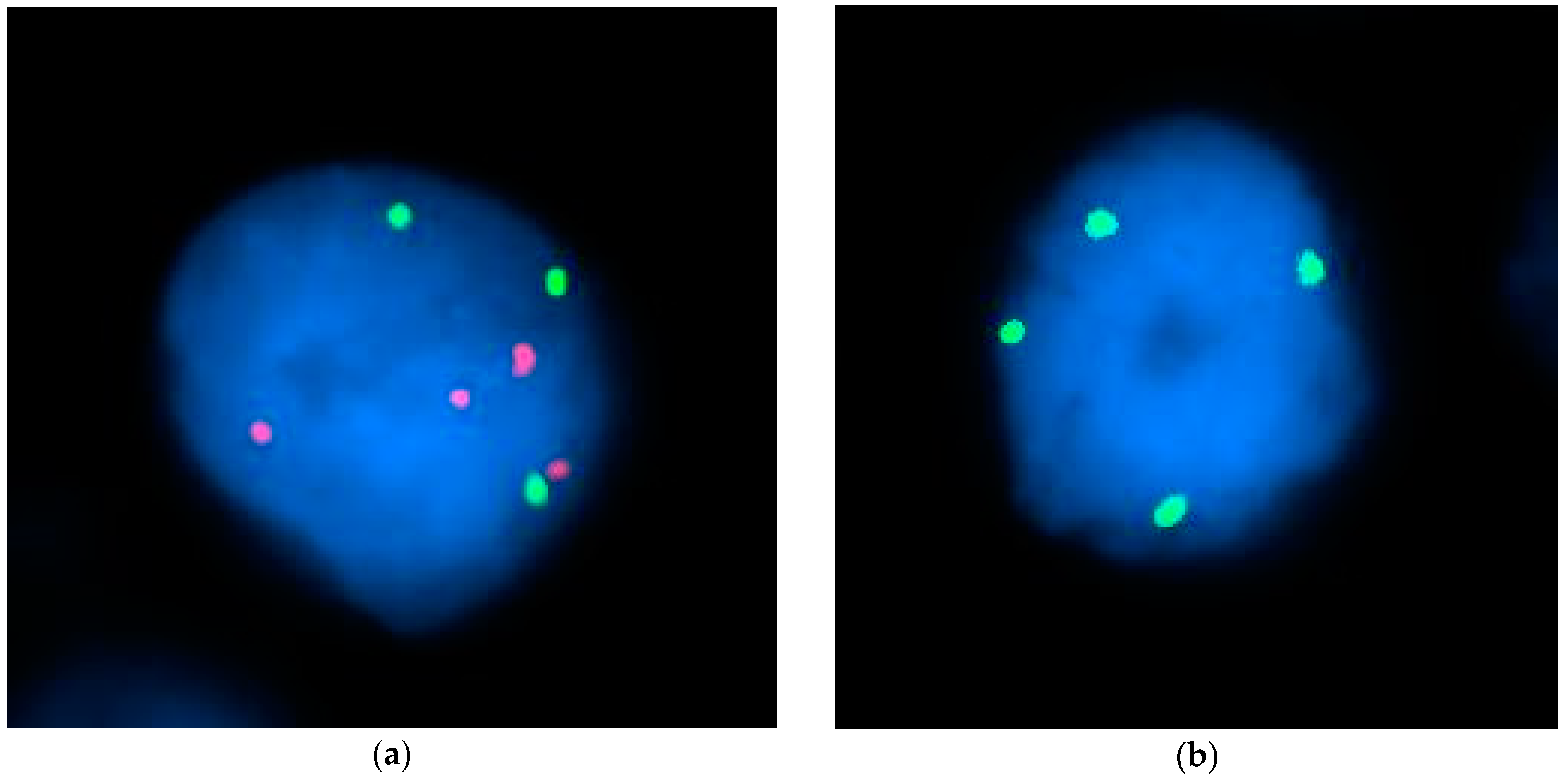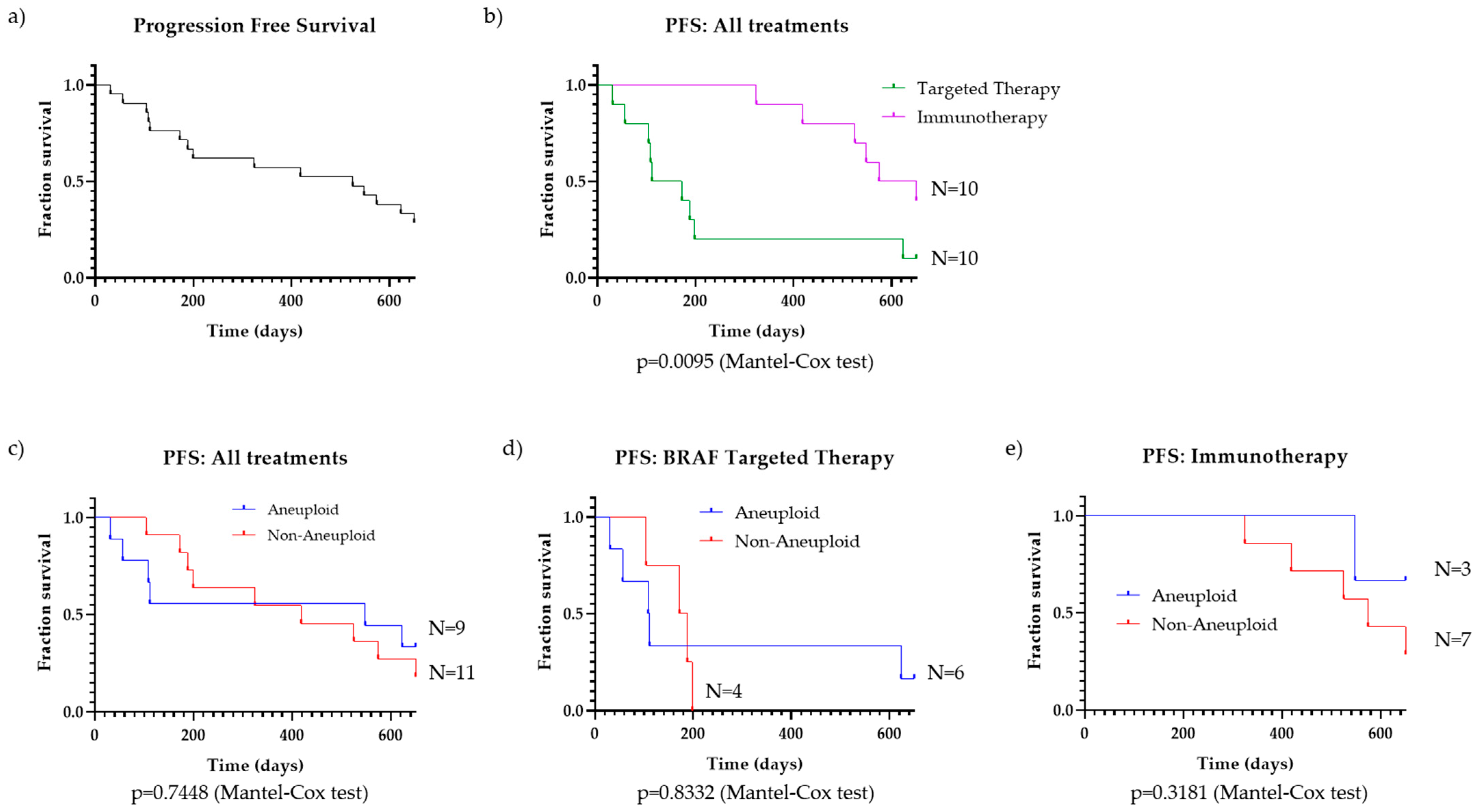Comparison of Immunotherapy versus Targeted Therapy Effectiveness in BRAF-Mutant Melanoma Patients and Use of cGAS Expression and Aneuploidy as Potential Prognostic Biomarkers
Abstract
Simple Summary
Abstract
1. Introduction
2. Materials and Methods
2.1. IRB Approvals
2.2. Sample Selection
2.3. FISH Staining
2.4. Immunofluorescence (IF) Staining
2.5. Image Collection
2.6. Image Analysis
3. Results
3.1. Patients Who Received First-Line Immunotherapy Have Improved Progression-Free Survival Compared to First-Line BRAF-Targeted Therapy
3.2. Certain Melanomas Exhibited Aneuploidy of Chromosomes 7, 11, and 18
3.3. cGAS Expression Has a Positive Correlation with Progression-Free Survival
4. Discussion
5. Conclusions
Author Contributions
Funding
Institutional Review Board Statement
Informed Consent Statement
Data Availability Statement
Acknowledgments
Conflicts of Interest
References
- Ascierto, P.A.; Kirkwood, J.M.; Grob, J.J.; Simeone, E.; Grimaldi, A.M.; Maio, M.; Palmieri, G.; Testori, A.; Marincola, F.M.; Mozzillo, N. The role of BRAF V600 mutation in melanoma. J. Transl. Med. 2012, 10, 85. [Google Scholar] [CrossRef]
- Czarnecka, A.M.; Bartnik, E.; Fiedorowicz, M.; Rutkowski, P. Targeted Therapy in Melanoma and Mechanisms of Resistance. Int. J. Mol. Sci. 2020, 21, 4576. [Google Scholar] [CrossRef] [PubMed]
- Atkins, M.B.; Lee, S.J.; Chmielowski, B.; Tarhini, A.A.; Cohen, G.I.; Truong, T.G.; Moon, H.H.; Davar, D.; O’Rourke, M.; Stephenson, J.J.; et al. Combination Dabrafenib and Trametinib versus Combination Nivolumab and Ipilimumab for Patients with Advanced BRAF-Mutant Melanoma: The DREAMseq Trial-ECOG-ACRIN EA6134. J. Clin. Oncol. 2023, 41, 186–197. [Google Scholar] [CrossRef] [PubMed]
- Ruggiero, C.F.; Fattore, L.; Terrenato, I.; Sperati, F.; Salvati, V.; Madonna, G.; Capone, M.; Valenti, F.; Di Martino, S.; Mandoj, C.; et al. Identification of a miRNA-based non-invasive predictive biomarker of response to target therapy in BRAF-mutant melanoma. Theranostics 2022, 12, 7420–7430. [Google Scholar] [CrossRef] [PubMed]
- Mourah, S.; Louveau, B.; Dumaz, N. Mechanisms of resistance and predictive biomarkers of response to targeted therapies and immunotherapies in metastatic melanoma. Curr. Opin. Oncol. 2020, 32, 91–97. [Google Scholar] [CrossRef] [PubMed]
- Berrino, E.; Balsamo, A.; Pisacane, A.; Gallo, S.; Becco, P.; Miglio, U.; Caravelli, D.; Poletto, S.; Paruzzo, L.; Debernardi, C.; et al. High BRAF variant allele frequencies are associated with distinct pathological features and responsiveness to target therapy in melanoma patients. ESMO Open 2021, 6, 100133. [Google Scholar] [CrossRef] [PubMed]
- Weaver, B.; Cleveland, D. Does aneuploidy cause cancer? Curr. Opin. Cell Biol. 2006, 18, 658–667. [Google Scholar] [CrossRef] [PubMed]
- Bakhoum, S.F.; Ngo, B.; Laughney, A.M.; Cavallo, J.-A.; Murphy, C.J.; Ly, P.; Shah, P.; Sriram, R.K.; Watkins, T.B.K.; Taunk, N.K.; et al. Chromosomal instability drives metastasis through a cytosolic DNA response. Nature 2018, 553, 467–472. [Google Scholar] [CrossRef] [PubMed]
- Bakhoum, S.F.; Cantley, L.C. The Multifaceted Role of Chromosomal Instability in Cancer and Its Microenvironment. Cell 2018, 174, 1347–1360. [Google Scholar] [CrossRef]
- Wörmann, S.M.; Zhang, A.; Thege, F.I.; Cowan, R.W.; Rupani, D.N.; Wang, R.; Manning, S.L.; Gates, C.; Wu, W.; Levin-Klein, R.; et al. APOBEC3A drives deaminase domain-independent chromosomal instability to promote pancreatic cancer metastasis. Nat. Cancer 2021, 2, 1338–1356. [Google Scholar] [CrossRef]
- Ben-David, U.; Amon, A. Context is everything: Aneuploidy in cancer. Nat. Rev. Genet. 2019, 21, 44–62. [Google Scholar] [CrossRef] [PubMed]
- Vasudevan, A.; Schukken, K.M.; Sausville, E.L.; Girish, V.; Adebambo, O.A.; Sheltzer, J.M. Aneuploidy as a promoter and suppressor of malignant growth. Nat. Rev. Cancer 2021, 21, 89–103. [Google Scholar] [CrossRef]
- Shteinman, E.R.; Wilmott, J.S.; da Silva, I.P.; Long, G.V.; Scolyer, R.A.; Vergara, I.A. Causes, consequences and clinical significance of aneuploidy across melanoma subtypes. Front. Oncol. 2022, 12, 988691. [Google Scholar] [CrossRef]
- Anagnostou, V.; Bruhm, D.C.; Niknafs, N.; White, J.R.; Shao, X.M.; Sidhom, J.W.; Stein, J.; Tsai, H.-L.; Wang, H.; Belcaid, Z.; et al. Integrative Tumor and Immune Cell Multi-omic Analyses Predict Response to Immune Checkpoint Blockade in Melanoma. Cell Rep. Med. 2020, 1, 100139. [Google Scholar] [CrossRef] [PubMed]
- Davoli, T.; Uno, H.; Wooten, E.C.; Elledge, S.J. Tumor aneuploidy correlates with markers of immune evasion and with reduced response to immunotherapy. Science 2017, 355, eaaf8399. [Google Scholar] [CrossRef] [PubMed]
- Hong, C.; Tijhuis, A.E.; Foijer, F. The cGAS Paradox: Contrasting Roles for cGAS-STING Pathway in Chromosomal Instability. Cells 2019, 8, 1228. [Google Scholar] [CrossRef] [PubMed]
- Oh, G.; Wang, A.; Wang, L.; Li, J.; Werba, G.; Weissinger, D.; Zhao, E.; Dhara, S.; Hernandez, R.E.; Ackermann, A.; et al. POLQ inhibition elicits an immune response in homologous recombination–deficient pancreatic adenocarcinoma via cGAS/STING signaling. J. Clin. Investig. 2023, 133, e165934. [Google Scholar] [CrossRef] [PubMed]
- Kim, H.; Kim, H.; Feng, Y.; Li, Y.; Tamiya, H.; Tocci, S.; Ronai, Z.A. PRMT5 control of cGAS/STING and NLRC5 pathways defines melanoma response to antitumor immunity. Sci. Transl. Med. 2020, 12, eaaz5683. [Google Scholar] [CrossRef]
- Vergara, I.A.; Mintoff, C.P.; Sandhu, S.; McIntosh, L.; Young, R.J.; Wong, S.Q.; Colebatch, A.; Cameron, D.L.; Kwon, J.L.; Wolfe, R.; et al. Evolution of late-stage metastatic melanoma is dominated by aneuploidy and whole genome doubling. Nat. Commun. 2021, 12, 1434. [Google Scholar] [CrossRef]
- Lukow, D.A.; Sausville, E.L.; Suri, P.; Chunduri, N.K.; Wieland, A.; Leu, J.; Smith, J.C.; Girish, V.; Kumar, A.A.; Kendall, J.; et al. Chromosomal instability accelerates the evolution of resistance to anti-cancer therapies. Dev. Cell 2021, 56, 2427–2439.e4. [Google Scholar] [CrossRef]
- Darp, R.; Vittoria, M.A.; Ganem, N.J.; Ceol, C.J. Oncogenic BRAF induces whole-genome doubling through suppression of cytokinesis. Nat. Commun. 2022, 13, 4109. [Google Scholar] [CrossRef] [PubMed]
- Cui, Y.; Borysova, M.K.; Johnson, J.O.; Guadagno, T.M. Oncogenic B-RafV600E Induces Spindle Abnormalities, Supernumerary Centrosomes, and Aneuploidy in Human Melanocytic Cells. Cancer Res 2010, 70, 675–684. [Google Scholar] [CrossRef] [PubMed]




| Patient | Gender | Age | Breslow Depth (mm) | Tissue Type | Stage | Location | Ulcerated * | Lymph Node Metastasis | Treatment |
|---|---|---|---|---|---|---|---|---|---|
| 1 | M | 86 | 11.6 | Primary | IIIB | Toe | Y | 1 | encorafenib |
| 2 | M | 51 | 4.3 | Primary | IV | Calf | Y | >1 | encorafenib |
| 3 | M | 72 | 3.0 | Primary | IV | Neck | N | >1 | encorafenib |
| 4 | M | 74 | 0.4 | Metastasis | IV | Groin | N | 1 | pembrolizumab |
| 5 | M | 54 | 1.2 | Primary | IIIA | Forearm | N | 1 | nivolumab |
| 6 | F | 29 | 1.4 | Primary | IIIA | Chest | N | 1 | trametinib/dabrafenib |
| 7 | M | 72 | 5.1 | Primary | IIIC | Buttock | Y | 1 | trametinib/dabrafenib |
| 8 | M | 51 | 5.4 | Primary | IIIC | Scalp | Y | >1 | dabrafenib/trametinib |
| 9 | M | 79 | 3.0 | Primary | IIIC | Ear | Y | >1 | enconrafenib/dabrafenib/trametinib |
| 10 | M | 55 | 6.0 | Primary | na | mid back | Y | >1 | vemurafenib |
| 11 | M | 45 | 2.9 | Primary | IIB | upper back | N | >1 | nivolumab |
| 12 | M | 64 | na | Primary | na | scalp | N | 1 | pembrolizumab |
| 13 | M | 69 | 4.5 | Primary | IIIC | thigh | N | >1 | pembrolizumab |
| 14 | F | 62 | 3.8 | Primary | IIIC | upper foot | Y | 1 | nivolumab |
| 15 | F | 52 | 6.4 | Primary | IIIC | thigh | Y | >1 | Nivolumab/pembrolizumab |
| 16 | M | 68 | 4.8 | Primary | IIB | scalp | Y | >1 | dabrafenib |
| 17 | M | 57 | 3.9 | Primary | IIIB | upper back | N | 1 | nivolumab |
| 18 | M | 55 | 1.3 | Primary | II | chest | Y | na | dabrafenib |
| 19 | M | 70 | na | Primary | na | scalp | na | na | ipilimumab |
| 20 | M | 30 | 1.8 | Primary | IIIa | lower back | N | one | pembrolizumab |
| Sample ID | Chromosome 7 Signal | Chromosome 11 Signal | Chromosome 18 Signal |
|---|---|---|---|
| 1 | 6.6 * | 4.3 * | 2 |
| 2 | 3.1 * | 2.9 | 3.1 * |
| 3 | 2.7 | 2 | 2.6 |
| 4 | 4.2 * | 1.5 | 3.2 * |
| 5 | 3 | 1.8 | 1.9 |
| 6 | 3.2 * | 3.4 * | 4.6 * |
| 7 | 3.4 * | 1.7 | 1.8 |
| 8 | 2.9 | 2.1 | 1.9 |
| 9 | 1.9 | 1.9 | 1.9 |
| 10 | 3.9 * | 3.2 * | 3.3 * |
| 11 | 2.4 | 1.4 | 2.7 |
| 12 | 2.3 | 1.7 | 2.1 |
| 13 | 2.7 | 2.5 | 2.8 |
| 14 | 4.3 * | 3.3 * | 1.9 |
| 15 | 2.5 | 1.9 | 3 |
| 16 | 2.7 | 2.1 | 3.1 * |
| 17 | 1.2 | 2 | 1.9 |
| 18 | 1.2 | 1.7 | 1.8 |
| 19 | 1.9 | 1.8 | 1.9 |
| 20 | 5.8 * | 3.2 * | 2.9 |
Disclaimer/Publisher’s Note: The statements, opinions and data contained in all publications are solely those of the individual author(s) and contributor(s) and not of MDPI and/or the editor(s). MDPI and/or the editor(s) disclaim responsibility for any injury to people or property resulting from any ideas, methods, instructions or products referred to in the content. |
© 2024 by the authors. Licensee MDPI, Basel, Switzerland. This article is an open access article distributed under the terms and conditions of the Creative Commons Attribution (CC BY) license (https://creativecommons.org/licenses/by/4.0/).
Share and Cite
Garrison, Z.; Clister, T.; Bleem, E.; Berry, E.G.; Kulkarni, R.P. Comparison of Immunotherapy versus Targeted Therapy Effectiveness in BRAF-Mutant Melanoma Patients and Use of cGAS Expression and Aneuploidy as Potential Prognostic Biomarkers. Cancers 2024, 16, 1027. https://doi.org/10.3390/cancers16051027
Garrison Z, Clister T, Bleem E, Berry EG, Kulkarni RP. Comparison of Immunotherapy versus Targeted Therapy Effectiveness in BRAF-Mutant Melanoma Patients and Use of cGAS Expression and Aneuploidy as Potential Prognostic Biomarkers. Cancers. 2024; 16(5):1027. https://doi.org/10.3390/cancers16051027
Chicago/Turabian StyleGarrison, Zachary, Terri Clister, Eric Bleem, Elizabeth G. Berry, and Rajan P. Kulkarni. 2024. "Comparison of Immunotherapy versus Targeted Therapy Effectiveness in BRAF-Mutant Melanoma Patients and Use of cGAS Expression and Aneuploidy as Potential Prognostic Biomarkers" Cancers 16, no. 5: 1027. https://doi.org/10.3390/cancers16051027
APA StyleGarrison, Z., Clister, T., Bleem, E., Berry, E. G., & Kulkarni, R. P. (2024). Comparison of Immunotherapy versus Targeted Therapy Effectiveness in BRAF-Mutant Melanoma Patients and Use of cGAS Expression and Aneuploidy as Potential Prognostic Biomarkers. Cancers, 16(5), 1027. https://doi.org/10.3390/cancers16051027






